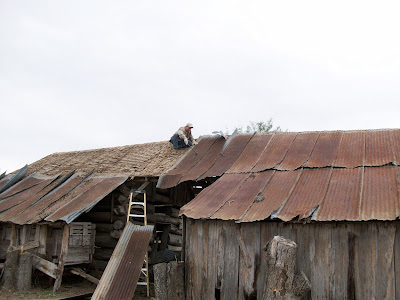This is a blog about a cabin, a fool (me) and an experiment in historic preservation.
I'm an 8th Generation Texan, raised-on-a-farm type of guy who has been forced - by economics only, I swear - to move to the big, ugly city. Nonetheless, I like everything rural and try to get out to the old farmstead as often as I can.
I'm a pretty big history buff and grew up in the history-rich landscape of Medina County, Texas, just west of San Antonio. The area was settled in 1844 by hardy folk from the Alsace-Lorraine area of what is now France, but which historically has been a mixture of French and German influences. The colony was founded in the late years of the Republic of Texas by Henri Castro, and its principle settlement was named after him: Castroville.
A number of other settlements were founded throughout the area, and some farmers often built stone homesteads in rural areas of the county.
In college, I travelled through Europe and saw cool, old stuff everywhere. Castles, old houses, stores and shops. Everywhere you looked, history looked back at you. I lamented the fact that we live in a disposable society here in America, and we have precious little history of our own.
It was only a few years later that I began to appreciate that we
do have history here in America. History everywhere around us. As I began driving the back roads of my home county, I realized that such history was just right below our noses. Driving around past isolated old farmsteads now abandoned, I was at once excited by how much was still there but at the same time aghast at the condition of the old relics.
"That's a nice old house," I used to tell my dad as we'd pass one of the old stone Alsatian settler homes where farmers had raised families and defended themselves against raids by Comanches and Apaches. "That's a nice old house," I'd say, "I wish somebody would fix it up."
Of course, living at the time off of the salary of a journalist, I never imagined that I could be one of those somebodies. But the bug of historic preservation began to grow inside me into a contagion of passion for preserving history. Gradually, as time went by, I noticed several of the old houses that I thought should be preserved were torn down. One house in the nearby town of Quihi, which had stood since the 1850s at least, was torn down to form a rock wall outside a modern, manufactured home. Another fell down on its own accord.
I was appalled. The City of Castroville had long since recognized the importance of historic preservation, and had preserved literally
hundreds of these old homes, but outside of the city, most were ignored. Those owners who did want to preserve them generally didn't have the money or the time.

I had decided that one day when I had a little bit of money, I'd do what I can to save one of these old houses. I had several in mind.
One house (to the left) I had seen in passing for years, along the side of F.M. 471 between Castroville and Rio Medina. In size and design, it was typical of the old Alsatian stone houses.
Alas, its location virtually guaranteed it could never be restored and used for any normal purpose. It sits literally fifteen feet from the side of the road. As a business or for storage, it could still be saved, but the location is too dangerous to ever contemplate as a living space.
Nonetheless, a few years ago, a new landowner began to start clearing the extensive brush which had overrun the property. Cutting down whole groves of hackberry trees, he uncovered for all the world to see a true gem - something I never even realized had existed. It wasn't just any other old house - but a log cabin dating to the very earliest days of settlement.

You see, early settlers generally didn't have a lot of time to design and construct houses. When they first arrived in their new home, the land was usually wilderness. The premium was on clearing the land and planting a crop.
Generally, then, the settlers built crude log cabins upon their first arrival, which they used for the first few, tough, hardscrabble years. Only as they began to eke out a living and become permanent dwellers did they have time to build permanent, stone houses.
In most cases, the old cabins they had build upon arrival were retained as outbuildings - barns, chicken coops or storage. Often, they were torn down and the wood recycled. Eventually, almost all vanished in the end.
But here, right before my eyes, was one of those original cabins. The stone house which had originally caught my eye was a mere successor - the permanent house they had built after a couple of years. And down the road about 200 yards was another, larger stone house. Eventually I confirmed my suspicions and found that the cabin had been replaced with the small stone house, which in turn had been replaced.
The dating of the houses will have to wait for later research to be confirmed, but the area was settled in the mid 1840s, and it is almost certain that the log cabin dates from that point. At some later juncture, an extension - made of boards - was added to the house. My forensic research - which I will discuss later - makes me think that this dates at least to the 1800s.
In September, 2007, I had just returned from Iraq (see my blog about that:
http://www.blogger.com/www.aalan94.blogspot.com ) and had a small amount of money available which I had put aside as a historic house rennovation fund. My hope was to find an old house on a small bit of land, and buy that to restore as a get-away place and a writer's cabin. I had my eyes on a couple of old houses, but one day I was driving past the old log cabin when I saw the landowner out cleaning up the property.
I stopped and chatted. He was a nice enough fellow. He said he wanted to try to fix up the old stone house one day, but nodded towards the old log cabin. "I'll probably tear that one down," he said. "It can't be fixed, and I'm thinking about putting a house there."
Right there, on the spot I told him I'd buy the house to save it. There was only one catch: he wasn't parting with the land, so the house would have to be moved. We negotiated for about 30 seconds, and for $1,500, I became the owner of a piece of history.
Of course, there was never a possibility of moving a stone house. They weigh too much, they would break apart and disassembly would be impossible - you'd have to mark and categorize thousands of small stones, not to mention clean them of plaster and replace them how they had been aligned before.
But a wooden cabin was a possibility.
I took a closer look at the house. (This is after the landowner finished cutting down the trees that were practically growing
through it.)

The most obvious part of the house is that it is a dog-run. This was a style common to old frontier houses throughout Texas and the South. Two separate buildings were joined by a breezeway, which kept the place cool in the winter. But in this particular case, the dog-run was an after-thought, since the log cabin was obviously built at one time and a board section of the house likely built later.
The house sits only about a mile from the Medina River - this was certainly the source of the cedar logs used in construction. All the other trees in the area - oak, mesquite and hackberry - are crooked and inadequate trees for a log cabin. The logs were likely carted to the location either by wagon or simply dragged by oxen.
The use of boards is a giveaway that the second section is much newer. Boards could be cut from trees locally or bought from lumber yards, but either way required a much more settled, organized society than the frontier would have been in the 1840s. (More on the history later).
The second thing that I noticed in my inspection of the house was its pronounced lean in the back:
This, along with the fact that the two halves of the building were not joined by anything besides the roof, argued against moving the house in one piece, and I soon came to the conclusion that the only possible thing to do was disassemble it.
Over the years, I had investigated the cost of house moving operations, and found that most such deals were out of my price range. I had already started thinking up schemes for how to take a house apart piece-by-piece, mark the pieces for reassembly, and rebuilding it.
All along the way, I decided that since I'm a relatively young guy with lots of energy, I would do as much work as possible by myself, only calling in the experts if necessary for such things as buidling a roof or plumbing or something I would likely screw up.
The fact that the building is a log cabin, of course, makes it even more appealing as a disassembly job. Once the roof is off - at least on the log half of the building - the logs can be taken apart by simply lifting them off of each other.
Driving back to Austin later that weekend, I called my brother to tell him about the project. He knew I had been thinking about something like this and when I told him I had bought the house, he was excited. He had seen it too, and liked the idea. "Cool," was his one-word response.
Later, as we would begin the arduous task of taking down the roof, I turned to my brother. "I think I misheard you that night," I told him. "I thought you said, 'Cool' but now I'm convinced that you meant to say, 'Fool.'"
Joking aside, I've embraced the project and will see it through to the end. The house will be disassembled and moved about 8 miles from its current location, to my family farm. There, when rebuilt - with a foundation and some improvements - it will become a living testament to the history of our pioneer forefathers.



 My logs after arriving. Although I ordered 10, I got one extra. I'm not complaining. I figured I'd probably need everything I could get.
My logs after arriving. Although I ordered 10, I got one extra. I'm not complaining. I figured I'd probably need everything I could get.




























 The back of the house, with the tin off.
The back of the house, with the tin off.











 Part cowboy, part frogman. The googles are necessary due to the immense amount of dirt wedged between the shingles, which blows into your face as you pull them off.
Part cowboy, part frogman. The googles are necessary due to the immense amount of dirt wedged between the shingles, which blows into your face as you pull them off. Getting under them with the shovel, I can take up to 2 or 3 rows at a time off, letting them fall to the ground.
Getting under them with the shovel, I can take up to 2 or 3 rows at a time off, letting them fall to the ground. 








